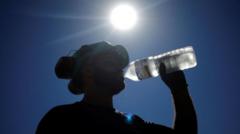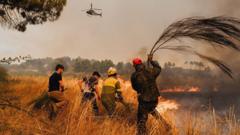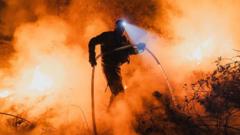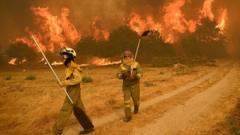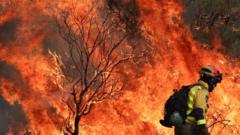The eastern regions of North America are grappling with the first significant heatwave of the summer, impacting over 160 million individuals and triggering urgent health warnings. This intense weather phenomenon spans from the US Midwest to the East Coast, extending into parts of Ontario, Quebec, and Nova Scotia in Canada.
Authorities caution that high humidity levels, combined with soaring temperatures, can exacerbate the risk of heat-related illnesses. The situation is made even more critical by the prolonged heatwave, with nighttime temperatures in certain eastern cities expected to remain above 80°F (27°C), leaving residents without much-needed relief.
This extreme heat arrives shortly after summer's official onset. Forecasters fear that numerous areas could witness record-breaking temperatures, particularly in the Mid-Atlantic region by Thursday and extending into the eastern Ohio Valley by Friday. Prolonged exposure to oppressive heat raises significant health concerns, particularly for vulnerable populations.
The US National Weather Service (NWS) has urged the public to be vigilant for signs of heat exhaustion and heat stroke, advising individuals to avoid outdoor activities during peak sun hours, stay hydrated, and check in on at-risk individuals, such as the elderly and those with health issues.
Many regions could surpass previous June temperature records, with New York City potentially hitting 101°F (38°C), matching the city's highest June recorded temperature from 1966. In response to the escalating demand for air conditioning, energy companies on the East Coast have urged customers to conserve electricity to prevent blackouts.
As people navigate the oppressive heat, effective strategies for cooling down are vital, emphasizing the importance of community awareness and individual responsibility.
Authorities caution that high humidity levels, combined with soaring temperatures, can exacerbate the risk of heat-related illnesses. The situation is made even more critical by the prolonged heatwave, with nighttime temperatures in certain eastern cities expected to remain above 80°F (27°C), leaving residents without much-needed relief.
This extreme heat arrives shortly after summer's official onset. Forecasters fear that numerous areas could witness record-breaking temperatures, particularly in the Mid-Atlantic region by Thursday and extending into the eastern Ohio Valley by Friday. Prolonged exposure to oppressive heat raises significant health concerns, particularly for vulnerable populations.
The US National Weather Service (NWS) has urged the public to be vigilant for signs of heat exhaustion and heat stroke, advising individuals to avoid outdoor activities during peak sun hours, stay hydrated, and check in on at-risk individuals, such as the elderly and those with health issues.
Many regions could surpass previous June temperature records, with New York City potentially hitting 101°F (38°C), matching the city's highest June recorded temperature from 1966. In response to the escalating demand for air conditioning, energy companies on the East Coast have urged customers to conserve electricity to prevent blackouts.
As people navigate the oppressive heat, effective strategies for cooling down are vital, emphasizing the importance of community awareness and individual responsibility.















